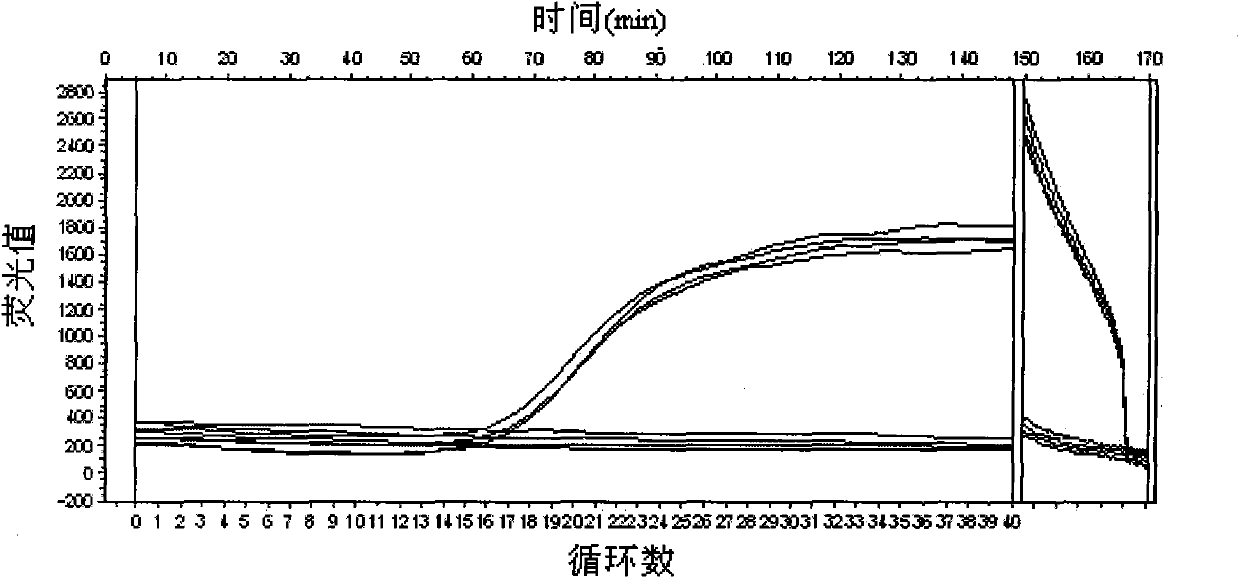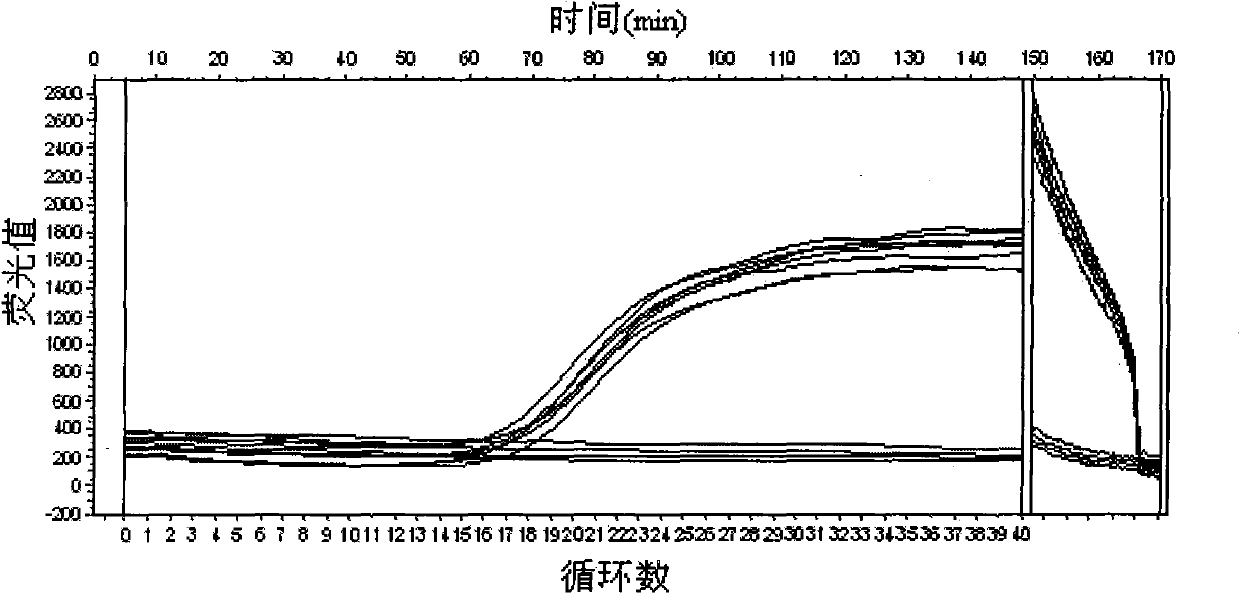Kit for fluorescence real-time quantitative PCR detection of Laribacter hongkongensis and detection method
A real-time quantitative, kit-based technology, applied in microorganism-based methods, fluorescence/phosphorescence, biochemical equipment and methods, etc., can solve problems such as troublesome and carcinogenic substances, and achieve the effect of simplifying experimental steps and improving detection limits.
- Summary
- Abstract
- Description
- Claims
- Application Information
AI Technical Summary
Problems solved by technology
Method used
Image
Examples
Embodiment 1
[0052] The kit for the detection of Hong Kong gull-type bacteria by fluorescent real-time quantitative PCR provided in this embodiment contains the following reagents in separate packages:
[0053] (1) 1 bottle of lysate, containing CTAB solution with a mass concentration of 10%, NaCl solution with a mass concentration of 4.1%, and SDS with a mass concentration of 0.1-0.5%;
[0054] (2) 1 bottle of proteinase K, containing 1mg / mL proteinase K;
[0055] (3) 1 bottle of extract, containing phenol, chloroform and isoamyl alcohol, described phenol: chloroform: the volume ratio of isoamyl alcohol is 25: 24: 1;
[0056] (4) 1 bottle of TE buffer solution, containing 0.1-0.5mol / L Tris-HCl (pH7.0) buffer solution, 50mmol / LEDTA;
[0057] (5) 1 tube of fluorescent PCR reaction solution, containing 1~2U hot start Taq enzyme, 3~5.5mmol / L Mg 2+ , 100~200μmol / L dNTPs, 1×PCR buffer, 1×SYBR Green I solution, 100~300nmol / L upstream and downstream primers, 1×PCR buffer contains 0.2~0.3mmol / L ...
Embodiment 2
[0082] Refer to Example 1 for the fluorescent real-time quantitative PCR detection kit provided in this example for the detection of Gull-type bacteria in Hong Kong.
[0083] The present embodiment utilizes above-mentioned fluorescent real-time quantitative PCR kit to detect the method for Hong Kong gull-type bacteria in the intestinal tract of sweet-scented osmanthus fish, comprising the following steps:
[0084]a) Put the sweet-scented osmanthus fish to death, put it on the dissecting tray, disinfect the body surface with 75% alcohol cotton balls, take out the fish intestines completely with a scalpel and scissors, and handle them carefully to avoid intestinal rupture, resulting in the omission of intestinal contents For contamination, remove the fat adhering to the intestines with a camera, dissect under aseptic conditions, take 1-2g of samples into a sterilized 5mL Eppendorf tube, cut the tissue in the tube with scissors until uniform, add 4mL of sterile water, fully oscill...
Embodiment 3
[0099] Refer to Example 1 for the fluorescent real-time quantitative PCR detection kit provided in this example for the detection of Gull-type bacteria in Hong Kong.
[0100] The present embodiment utilizes the above-mentioned fluorescent real-time quantitative PCR kit to detect the method for Hong Kong gull-type bacteria in the intestinal tract of grass carp carp, comprising the following steps:
[0101] a) Put the grass carp to death, put it on the dissection tray, disinfect the body surface with 75% alcohol cotton balls, take out the fish intestines with a scalpel and scissors, and handle them carefully to avoid intestinal rupture, which may cause omission of intestinal contents Contamination, remove the fat adhering to the intestine with a camera, dissect under aseptic conditions, take 0.5-2g sample into a sterilized 5mL Eppendorf tube, cut the tissue in the tube with scissors until uniform, add 4mL sterile water, fully oscillate to suspend, Centrifuge at 4000rpm in a cent...
PUM
 Login to View More
Login to View More Abstract
Description
Claims
Application Information
 Login to View More
Login to View More - R&D
- Intellectual Property
- Life Sciences
- Materials
- Tech Scout
- Unparalleled Data Quality
- Higher Quality Content
- 60% Fewer Hallucinations
Browse by: Latest US Patents, China's latest patents, Technical Efficacy Thesaurus, Application Domain, Technology Topic, Popular Technical Reports.
© 2025 PatSnap. All rights reserved.Legal|Privacy policy|Modern Slavery Act Transparency Statement|Sitemap|About US| Contact US: help@patsnap.com



